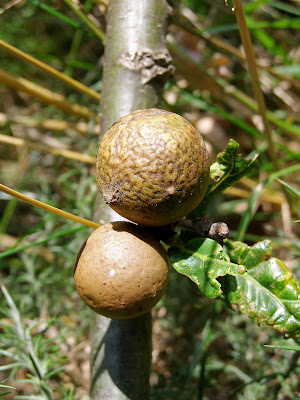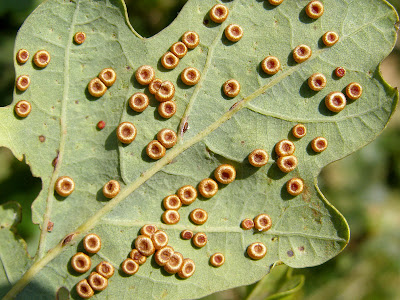A series of galls this morning following our walk. We ventured around Mapperley Reservoir, in the hope that it would be dry enough under foot. It was, but only just. A beautiful day for a walk, as the sun shone and it was very warm. In the sunshine, the Oak trees beside the paths were covered in the galls produced by various insects species. First, the Marble Gall.
These hard, brown galls about 1" across are made by a tiny gall wasp with the catchy name of Andricus kollari. These insects are no more than 2mm long and have a strange life cycle. They produce two generations each year, the first generation containing males and females which reproduce to make the second generation all of which are females and need no males to reproduce.
Secondly the Knopper Gall.
This gall is produced by another insect, this time by the name of Andricus quercuscalicis. The 'knobbly' gall is produced on the growing acorns of the Oak tree and make extremely strange and beautiful shapes. These galls only appeared in Britain in the 1960 as the insect needs a species of Oak called Quercus cerris which is not a native and itself only began to spread in Britain in the 60's. The Knopper Gall (on the native Oak Tree Quercus robur) contains the asexual insect larvae which break out as adults in Spring ready to produce the next generation on the catkins of the Quercus cerris. Very complicated life!
Lastly a very small gall on the underside of the Oak leaves.
These are Silk Button Galls and are produced by the Gall Wasp, Neuroterus numismalis. Again, these are the asexual generation of the wasp, the sexual adult insects then produce other galls on the catkins and leaves of Oaks in the Spring.
I think you will agree, these tiny insects have a most extraordinary life cycle.



No comments:
Post a Comment